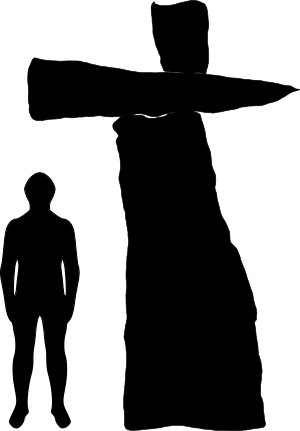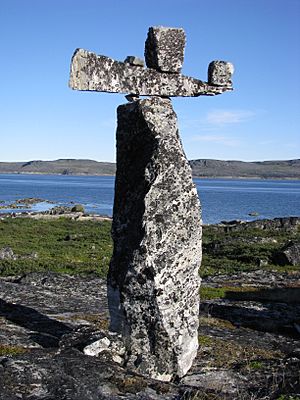Hammer of Thor (monument) facts for kids

The Hammer of Thor is a very tall, T-shaped rock structure. It was built by people a long time ago. You can find it along the Arnaud River in Quebec, Canada.
An archaeologist found this unique monument in 1964. He thought it might have been built by Vikings. He named it "The Hammer of Thor" because it looked like a hammer. This name also refers to Thor, a powerful god from Norse culture who carried a hammer.
Contents
What is the Hammer of Thor?
The Hammer of Thor is made of three large rocks stacked together. It has a tall, straight bottom part. On top of that is a rock placed across it, like the top of a 'T'. Finally, a smaller rock sits on the very top.
How Big is the Hammer of Thor?
The bottom part, called the shaft, is about 2.4 meters (8 feet) tall. The rock placed across it is about 1.4 meters (4.5 feet) long. The top rock is about 36 centimeters (14 inches) high.
The whole monument stands about 3.3 meters (11 feet) tall. It is estimated to weigh around 1,800 kilograms (4,000 pounds). That's like the weight of a small car!
Where is the Hammer of Thor Located?
This interesting rock structure is on the north side of the Arnaud River. This river used to be called the Payne River. The monument is about 24 kilometers (15 miles) from Payne Bay. It is near the western coast of Ungava Bay in the Ungava Peninsula, Quebec, Canada.
How Was the Hammer of Thor Discovered?
The monument was found in 1964 by an archaeologist named Thomas E. Lee. He was on a trip to the Ungava Peninsula to study people and cultures. The Hammer of Thor had been standing there for many years. No one in the area knew who had built it.
Who Built the Hammer of Thor?
Local Inuit people had stories that the monument was there before their ancestors arrived. Thomas Lee thought the structure looked like something Europeans would build. He believed it was proof that Norse people (Vikings) lived in the Ungava area about a thousand years ago. Because it looked like a hammer, Lee gave it the name "The Hammer of Thor."


